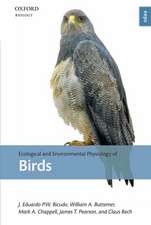Water and Life: Comparative Analysis of Water Relationships at the Organismic, Cellular, and Molecular Levels
Editat de George N. Somero, Charles B. Osmond, Carla L. Bolisen Limba Engleză Paperback – 22 dec 2011
Preț: 644.82 lei
Preț vechi: 758.60 lei
-15% Nou
Puncte Express: 967
Preț estimativ în valută:
123.43€ • 134.11$ • 103.74£
123.43€ • 134.11$ • 103.74£
Carte tipărită la comandă
Livrare economică 21 aprilie-05 mai
Preluare comenzi: 021 569.72.76
Specificații
ISBN-13: 9783642766848
ISBN-10: 3642766846
Pagini: 388
Ilustrații: XI, 371 p.
Dimensiuni: 155 x 235 x 20 mm
Greutate: 0.54 kg
Ediția:Softcover reprint of the original 1st ed. 1992
Editura: Springer Berlin, Heidelberg
Colecția Springer
Locul publicării:Berlin, Heidelberg, Germany
ISBN-10: 3642766846
Pagini: 388
Ilustrații: XI, 371 p.
Dimensiuni: 155 x 235 x 20 mm
Greutate: 0.54 kg
Ediția:Softcover reprint of the original 1st ed. 1992
Editura: Springer Berlin, Heidelberg
Colecția Springer
Locul publicării:Berlin, Heidelberg, Germany
Public țintă
ResearchDescriere
Presenting an analysis of the water relationships of the major groups of organisms: fungi, plants and animals, the text examines water stress at all levels of biological organization. Topics covered include: 1) organic osmotic agents: their distributions, modes of action, and mechanisms of regulation; 2) desiccation stress; mechanisms for preserving cellu lar integrity under conditions of low cellular water activity; 3) water stress and water compartmentation in plants; and 4) freezing stress: the prevention and regulation of ice formation in biological fluids, and mechanisms for overcoming the damaging effects of low temperatures on cellular integrity. Common adaptive strategies in diverse organisms are emphasized, as well as the fundamental physical-chemical properties of aqueous solutions that establish the nature of the interactions among water, low molecular weight solutes and macromolecules.
Cuprins
I Osmotic Solutes: Evolution, Function, and Regulation.- 1: Adapting to Water Stress: Convergence on Common Solutions.- 2: Compatible and Counteracting Aspects of Organic Osmolytes in Mammalian Kidney Cells in Vivo and in Vitro.- 3: Molecular Basis for Accumulation of Compatible Osmolytes in Mammalian Cells.- 4: Compatible Solute Synthesis and Compartmentation in Higher Plants.- 5: Osmotic Control of Transcription of the pro U Operon of Salmonella typhimurium.- 6: A Physicochemical Basis for the Selection of Osmolytes by Nature.- II Desiccation Stress.- 7: Membrane Integrity in Anhydrobiotic Organisms: Toward a Mechanism for Stabilizing Dry Cells.- 8: Water Content and Metabolic Organization in Anhydrobiotic Animals.- 9: Macroautophagy Triggered by Sucrose Starvation in Higher Plant Cells: Analysis of a Model for Prolonged Carbon Deprivation Under Water Stress.- 10: Desiccation Tolerance in Vegetative Plant Tissues and Seeds: Protein Synthesis in Relation to Desiccation and a Potential Role for Protection and Repair Mechanisms.- 11: Water in Dry Organisms.- III Plant-Water Compartmentation and Water Stress.- 12: The Biophysics of Plant Water: Compartmentation, Coupling with Metabolic Processes, and Flow of Water in Plant Roots.- 13: Water Compartmentation in Plant Tissue: Isotopic Evidence.- 14: Photosynthetic Water Oxidation and Water Stress in Plants.- 15: Desiccation and Freezing Phenomena for Plants with Large Water Capacitance — Cacti and Espeletias.- IV Freezing Stress.- 16: Ice Nucleating Agents in Cold-Hardy Insects.- 17: Hemolymph Proteins Involved in the Cold Tolerance of Terrestrial Arthropods: Antifreeze and Ice Nucleator Proteins.- 18: The Role of Antifreeze Glycopeptides and Peptides in the Survival of Cold-water Fishes.- 19: Freeze Thaw Injury and Cryoprotection of Thylakoid Membranes.- 20: Freeze-Induced Dehydration and Membrane Destabilization in Plants.







